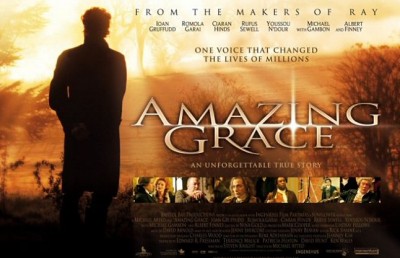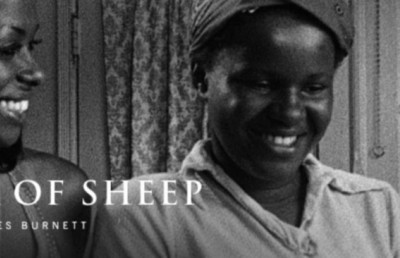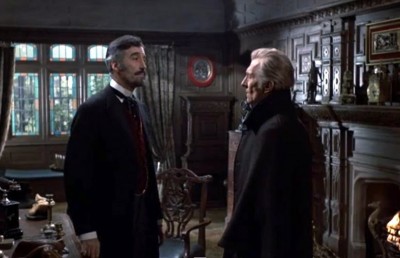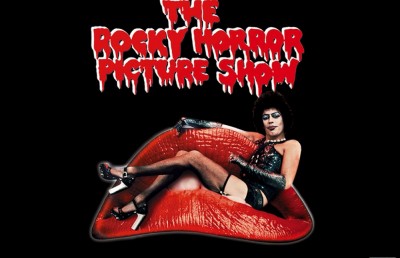Dead in the Water? Dream and Reality in Carnival of Souls
The Eternal Circle of Life and Death
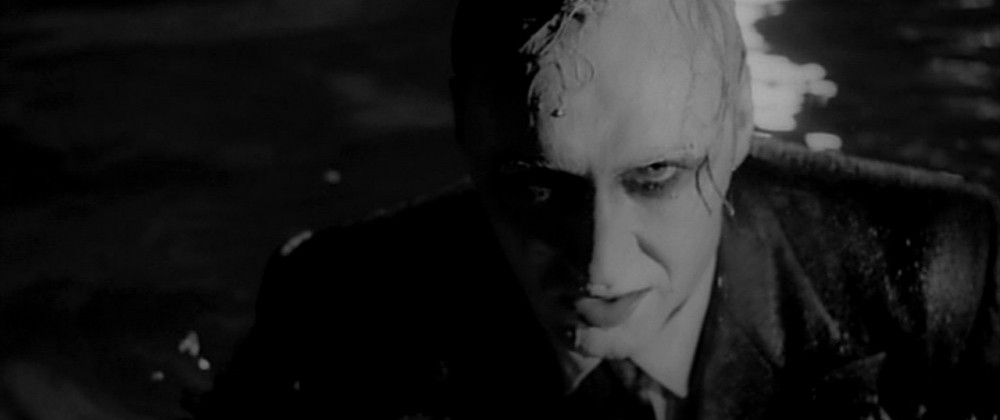
Carnival of Souls (Herk Harvey, 1962) is a strange, atmospheric and unforgettable low-budget horror film. The film focuses on a young church organist Mary Henry (Candace Hilligoss) who is haunted by visions of a ghoulish netherworld after surviving what appears to be certain death when a car in which she is a passenger, plunges over the edge of a bridge into the river below.
Amateurish in many ways (the film does include some stilted performances, bad lip-synching, clunky editing and a few continuity errors), Carnival of Souls nevertheless continues to exert a strange fascination for many viewers. Not a conventional horror or ghost story, Carnival of Souls explores the psychological state of Mary Henry after she emerges, apparently unharmed, from the murky depths of the river. Moreover, Carnival of Souls raises a number of perplexing questions that relate to the existence of Mary Henry, without providing any definitive answers. Has Mary really survived what appears to be certain death? Is she already dead? Does she exist in the real world or some parallel universe? One plausible interpretation of Carnival of Souls is that the film represents a hallucinatory dream –or nightmare– that Mary is experiencing in the split second before the car plunges into the river and she plummets to her death.
Carnival of Souls opens with Mary Henry and two other young women competing in a drag race with local youths in a rural Kansas town. Suddenly, the car containing the three women crashes through the railings of a bridge and into the murky depths of the river below. As the sheriff and various local residents dredge the river, all three women are presumed to have drowned. However, several hours later (time is never made clear), in what seems to be a bizarre twist of fate, Mary emerges mysteriously from the river, clamouring up the sandy embankment, barefoot, muddy and bedraggled (but strangely not wet). After having apparently recovered from her ordeal, Mary accepts a new job as an organist at a local church in Utah. But, while driving to Utah, Mary is haunted by a ghoulish apparition (incidentally played by director Herk Harvey), a deathly pasty-faced figure clad in a tuxedo, with black-rimmed eyes and caked white hair (who comes to be known only as “the man”). Arriving in Salt Lake City, Mary finds accommodation in a small rooming house run by a garrulous landlady (Frances Feist). Mary also meets the other sole housemate John Linden (Sidney Berger) who makes crude and drunken advances towards her. However, as the film progresses Mary continues to be haunted by “the man,” even inside the sacred realm of the church, where she is told by the resident Minister (Art Ellison) to leave because of her “sacrilegious” organ playing. Moreover, the ghastly apparition of “the man” seems to be drawing Mary inexorably toward a strange old abandoned lakeside carnival that rises like a shadowy spectre on the outskirts of town. Becoming progressively withdrawn and detached, Mary appears to drift in and out of the world around her. There are even occasions when she seems to be invisible; people can neither see nor hear her. Increasingly drawn to the old abandoned carnival site, Mary is finally lured by “the man” to take part in a macabre “dance of death” with other ghouls in the disused ballroom inside the old pavilion. Carnival of Souls inexplicably finishes where it began, back at the bridge, with the car being hauled out of the river. It appears that all three women in the car are now dead, including Mary Henry.
On its original release in 1962, Carnival of Souls was confined primarily to drive-in movie houses (sharing the bill with a horror film called The Devil’s Messenger, a feature length pilot shot for Swedish TV in 1961, starring Lon Chaney Jnr. and directed by Herbert L. Strock, with an uncredited Curt Siodmak). [1] Quickly disappearing after its original release, Carnival of Souls was to acquire an increasing “cult” following over the next 25 years, largely due to its repeated screenings on late-night US television. The eventual resurrection of Carnival of Souls came when the film was re-released and re-evaluated in the late 1980s. Restored by Panorama Entertainment in 1989, the re-release of Carnival of Souls also contained several minutes of extra footage. In addition, the film finally received a proper New York theatrical release in August 1989 [2] and also screened at various film festivals throughout the US (including the USA Film Festival in Dallas). [3] In November 1989, there was even a cast and crew reunion at the house in Lawrence Kansas, where much of the interior action in the movie was originally filmed. [4]
Importantly, the eerie, surreal and disjointed atmosphere created so effectively in Carnival of Souls has been influential on other filmmakers. It seems fair to assume that director George A. Romero must have seen Carnival of Souls before he made his cult horror classic Night of the Living Dead (1968). The ghouls in Carnival of Souls certainly resemble the flesh-eating beings in Night of the Living Dead. Moreover, the otherworldly atmosphere created in Carnival of Souls seems to have been influential on the “dreamlike” and surreal creations of David Lynch, particularly Eraserhead (1978). As a measure of its enduring popularity, Carnival of Souls was also re-made in 1998, in a vastly inferior version directed by Adam Grossman and Ian Kessner (the film is also known as Wes Craven Presents Carnival of Souls).
Significantly, Carnival of Souls was the only feature film to be directed by industrial and educational filmmaker Harold (Herk) Harvey. After completing Carnival of Souls, Harvey was to return to making industrial and educational films before retiring in the late 1980s (he died in 1996). [5] Born in Colorado, Harvey majored in theatre at Kansas University, directing and acting in stage productions (Harvey was to return many years later to the University of Kansas, teaching filmmaking for a brief period in the late 1980s). Beginning his film career as an actor, Harvey appeared in educational and industrial films made by the Centron Corporation, a production company located in Lawrence Kansas. Subsequently becoming a director for Centron, Harvey went on to direct more than 200 industrial and educational films for the company, before taking a working vacation in 1961 to try his hand at feature filmmaking. [6]
The initial inspiration for Carnival of Souls came when Harvey, while driving through Utah in 1961, spotted the ornate ruin of Saltair amusement park located on the arid shore of the Great Salt Lake. Dating from the 1920s, the massive carnival pavilion, with its imposing Eastern European turrets, had once housed a salt-water bath resort and then a carnival. However, changing times, shifting tastes, as well as a receding lake (floating in salt water had been one of the attractions) had put the resort out of business. [7] By the early 1960s, Saltair had become dilapidated and condemned, a crumbling landmark rising like a spectre outside Salt Lake City. Interviewed in 1989, Harvey remembered first seeing the old amusement pavilion, “It was sunset and I was driving to Kansas from California when I first saw Saltair. It’s an amusement park located at the end of a half-mile causeway out into the Great Salt Lake. The lake had receded and the pavilion with its Moorish towers stood silhouetted against the red sky. I felt I had been transported into a different time and dimension. I couldn’t believe what I was seeing. I stopped the car and walked out to the pavilion. The hair stood up on the back of my neck. The stark white of the salt beach and the strange dark quiet of the deserted buildings made it the spookiest location I had ever seen.” [8] Harvey returned to Kansas and enlisted the services of his friend John Clifford, a co-worker and writer at Centron Films, to develop a script with the Saltair amusement park as the central premise. As Harvey later explained: “The last scene, I told him (Clifford), had to be a whole bunch of ghouls dancing in that ballroom; the rest was up to him. He wrote it in three weeks.” [9]
With the combination of Harvey’s original concept and Clifford’s script, the next step –raising enough funds to make a first feature length film– was not going to be easy. The original budget for Carnival of Souls was a miniscule US $17.000. In addition, Harvey was able to raise another US $13,000 from various acquaintances in and around Lawrence Kansas, bringing the final total to US $30.000. [10]
Carnival of Souls was shot in 1961, by Harvey and just six crew-members over a three week period in and around Kansas and Utah, with one week at the Saltair amusement park and two weeks in Lawrence Kansas (the opening drag race scene was filmed at Kaw Bridge in Salt Lake City, Kansas). Working seven days a week and sometimes around the clock, Harvey not only directed Carnival of Souls, but also produced the film and (as mentioned above) co-starred as “the man” (which no doubt helped to keep budget costs down). [11]
Carnival of Souls consisted almost entirely of local amateur performers (Sidney Berger, who played John Linden, was then a graduate acting student at the University of Kansas). [12] The only professional actor in the cast was Candace Hilligoss, who played Mary Henry. Hilligoss was a New York actress trained at Lee Strasberg’s famous Actor’s Studio. [13] In a 1990 interview, Hilligoss reflected on Carnival of Souls: “I was paid $2,000 for doing the film. It seemed like a fortune, so much so that my husband quit his job as a waiter to concentrate on his acting career and got his first Broadway part almost immediately.” [14]
It is important to note that when Carnival of Souls was completed, Harvey had difficulty finding a distributor for the film. Eventually, a company called Herts-Lion agreed to distribute Carnival of Souls. However, the tenuous agreement with Herts-Lion meant that Harvey and writer John Clifford were to accept no money up front, only a percentage of the profits. After the film was completed, Harvey then left for South America to continue his career making educational films for Centron. On his return to Kansas, Harvey became aware that Carnival of Souls had done decent business at drive-in theatres in the Southern States of the US, double-billed with The Devil’s Messenger. Significantly, Harvey also found out that he and Clifford were contractually unable to stop Herts-Lion from clipping nine minutes from the film. According to Clifford, this act was a hack job that nearly destroyed the film’s intended moodiness. As Clifford explained many years later, “The theatrical version was really chopped up. They cut out the beginnings of scenes, and the timing just wasn’t right.” [15] To add insult to injury, when Harvey contacted Herts-Lion for his (and Clifford’s) share of the profits, the cheque sent by the company bounced. Herts-lion was to go out of business soon after. The years went by, with Carnival of Souls steadily growing in stature among late-night television viewers. Unfortunately, scratchy prints were being screened (the original print was gathering dust in the vaults of D-Arts Labs, the result of Hert-Lion’s non-payment of the lab bill). Thankfully, after years of anguish, Harvey was finally able to buy back the original print of Carnival of Souls for a token amount and restore the extra footage. [16]
As mentioned above, Carnival of Souls can be interpreted as the “dream-like” state that Mary is experiencing in the split second before her death. Although Mary appears to have miraculously survived the car crash, it soon becomes apparent as the film progresses, that there is something different about her. It’s as if Mary is flickering in and out of existence; that she appears to inhabit an “otherworldly” or “parallel universe.” This strange surreal atmosphere in Carnival of Souls is highlighted by the eerie organ music (by composer Gene Moore), which punctuates the entire film. This unsettling and discordant organ score, a combination of strange carnival music and off-kilter funeral dirge, is very effective in creating an unsettling mood, which signals a separation between the otherworldly existence Mary appears to be experiencing and the reality of the world around her. This separation between dream and reality is demonstrated very effectively in the scene when Mary, while driving to Salt Lake City, switches on the car radio and flicks up and down the dial. However, the only music she can hear is the macabre organ score that doesn’t appear to be coming from the car radio, but seems to be playing in her head. Gene Moore’s incessant score is again highlighted later in the film in a scene with Mary playing the church organ. As she plays, the organ music becomes more unsettling and ominous. Mary appears to be in a hypnotic trance-induced state of mind; wide-eyed and zombie-like, swaying from side to side, unable to stop or control the organ music swirling around her –drawn by visions of “the man” and other ghouls to the sinister old carnival pavilion.
The stark black and white cinematography (by Maurice Prather) in Carnival of Souls also provides an unsettling dream-like atmosphere –the feeling of a recurring nightmare. This dream-like imagery is perfectly exemplified in a scene when Mary, obsessed with the old pavilion, walks through the disused dance hall, which still has decorations hanging limply from the roof; the remnants of a bygone era. An overhead shot, with the camera tilted to capture a surreal and otherworldly environment, emphasizes a shadowy sense of foreboding. In addition, recurring shots of “ the man” opening his eyes and emerging from beneath the Salt Lake, as well as other pasty-faced ghouls rising ominously from beneath the lake (These scenes were actually filmed in an apartment swimming pool in Kansas) [17] provide a deathly presence, constantly luring Mary to the old pavilion. Ultimately, Mary’s obsession with the old pavilion culminates in a macabre “dance of death” with other deathly ghouls on the old dance floor festooned with decaying decorations, which seems to signify that Mary has ceased to exist in this world and has now entered the world of the dead.
If Carnival of Souls is interpreted as a dream (or nightmare) that Mary is experiencing between the time the car in which she is a passenger plunges over the bridge, and the last scene in the film when the car is dredged up with what appears to be three dead women inside (including Mary), then one particular sequence in the film could be described as a dream-within-a-dream. Banished from the church for her “sacrilegious” organ playing and continually haunted by “the man,” Mary decides to leave Salt Lake City. However, she has car trouble and pulls into a local garage to have it checked. Frightened, Mary decides to stay in her car as it is hoisted up on a hydraulic ramp. Suddenly, the shadowy apparition of ”the man” enters the darkened garage through an open door and appears to let her car down from the ramp. Escaping from her car and the clutches of “the man,” Mary runs into the street. Entering a bus depot, Mary frantically asks directions for the next bus out of town, but no one appears to see or hear her (and she can’t hear anyone). It’s as if Mary is invisible; that she no longer exists in this world. Moreover, the ominous macabre organ score also appears to signify that Mary is entering some kind of parallel universe. Adding to this unsettling dreamlike atmosphere, a monotone otherworldly voice (that only Mary seems to hear) announces that the eastbound bus is now loading from gate nine. Mary runs towards the stationary bus, only to find to her horror that the passengers inside are deathly ghouls who (like “the man”) seem to be reaching out to her. Fleeing from the bus, Mary runs aimlessly through the streets, with the incessant organ music playing in her head. Emotionally distraught, Mary eventually finds herself back at the office of doctor Samuels (Stan Levitt). As she tries to explain what is happening to her, neither Mary (nor we, the viewer) can see the doctor. He is facing away from Mary, hidden by a high-backed chair. Unexpectedly, the chair swivels around to reveal, not doctor Samuels, but the pasty-faced apparition of “the man.” Then suddenly, Mary is back sitting in her car at the garage. What could be construed as a dream-within-a-dream sequence appears to reinforce the notion that Mary is experiencing some kind of hallucinatory nightmare in the moments before her death.
Significantly, the notion of “it was all just a dream” certainly wasn’t an original concept, either in print or on the screen, when Carnival of Souls was originally released in 1962. Whether or not it was intentional, there are aspects of the story in Carnival of Souls that appear to possess more than a passing resemblance to An Occurrence at Owl Creek Bridge, a short story originally written in 1890 by British horror author Ambrose Bierce (An Occurrence at Owl Creek Bridge was also made into a 28 minute French short film in 1962, written and directed by Robert Enrico. Virtually silent, the film won first prize for short subjects at the 1962 Cannes Film Festival). As the title suggests, An Occurrence at Owl Creek Bridge, like Carnival of Souls, also uses a bridge as the premise of its story. Set during the American Civil War, An Occurrence at Owl Creek Bridge centres on a convicted Confederate saboteur, Peyton Farquhar, who is about to be hanged at a makeshift gallows overlooking the Owl Creek Bridge. Miraculously, Farquhar appears to get a reprieve when the rope around his neck suddenly snaps. Plunging into the raging river below the bridge, Farquhar desperately swims to shore, finally makes his way home where his wife and children are waiting for him. However, as he is about to embrace his wife, Farquhar feels his neck breaking. Suddenly, he is back at Owl Creek Bridge, dangling at the end of the hangman’s rope. [18] Like Carnival of Souls, An Occurrence at Owl Creek Bridge can also be interpreted as the dream that occurs in the split second before death (in this instance, a dying Confederate saboteur). In An Occurrence at Owl Creek Bridge, Peyton Farquhar appears to dream of his escape in the split second before the rope tightens around his neck and he is left dangling over Owl Creek Bridge. In Carnival of Souls, it is Mary Henry who seems to be dreaming in the split second before she plummets to her death as one of the passengers in a car that plunges over the edge of Kaw Bridge in Salt Lake City.
It is also worth noting that the French short film version of An Occurrence at Owl Creek Bridge was screened in 1964 as an episode of The Twilight Zone, an imaginative and enduring US television series created and presented by Rod Serling in the early 1960s. Significantly, another episode of The Twilight Zone, entitled The Hitchhiker consists of a story that bares similarities to both Carnival of Souls and An Occurrence at Owl Creek Bridge. The Hitchhiker was originally a radio play written by Lucille Fletcher (Wife of legendary composer Bernard Hermann, Fletcher was also the author of Sorry, Wrong Number, filmed in 1948, directed by Anatole Litvak, and starring Barbara Stanwyck and Burt Lancaster). The Hitch-Hiker then became a Mercury Theatre production starring Orson Welles as a driver on a cross-country trip from Brooklyn to California who, after an auto accident, repeatedly encounters the same hitchhiker. [19]
Adapted for The Twilight Zone by creator Rod Serling, The Hitchhiker screened on US television in 1960. The Twilight Zone episode of The Hitchhiker concerns a young woman Nan Adams (played by Inger Stevens) who is involved in a car accident. Although Nan appears to be unhurt, she begins to repeatedly see the same ominous hitchhiker, a dishevelled little man who constantly beckons her. No matter how fast or how far Nan drives, the hitchhiker is always ahead of her. Finally, in desperation, she calls home, only to be told that her mother has suffered a nervous breakdown following the death of her daughter Nan. [20] Appearing before Carnival of Souls originally screened in 1962, it is possible that The Hitchhiker may have influenced both director Herk Harvey and writer John Clifford. In addition, just like the ghoulish apparition (“the man”) who haunts Mary Henry in Carnival of Souls, the dishevelled little man in The Hitchhiker can also be interpreted as “death” reaching out to Nan Adams in the split second before she dies in a car accident. Moreover, just before The Hitchhiker concludes, Nan finally allows the strange man (“death”) to get into her car, which could be interpreted as signifying that she has now ceased to exist in this world.
Carnival of Souls would certainly not be considered one of the great masterpieces of the cinema. As mentioned above, the film is amateurish in many ways (although it could be argued that some stilted performances, bad lip-synching, clunky editing and a few continuity errors actually add to the film’s eerie atmosphere of other-worldliness). In addition, the scenes between Mary and the lecherous John Linden halfway through Carnival of Souls could be criticized for slowing the flow of the film, as well as being an unnecessary diversion from the horrific tension that has been slowly building up to that point (although it may also be agued that these scenes do serve to further illustrate Mary’s disassociation from the world around her, while providing a momentary glimpse into a more “human” side of her character).
However, there is no doubt that Carnival of Souls, categorized as a B-grade low-budget horror film on its original release in 1962, has become a “cult” classic over the ensuing years. Indeed, it needs to be acknowledged that Carnival of Souls is a tremendous achievement for both first-time feature director Herk Harvey and first time feature writer John Clifford. Moreover, Carnival of Souls, despite its low budget, is constantly inventive and imaginative, both visually and aurally, cleverly creating an unforgettably otherworldly atmosphere. In addition, Candace Hilligoss as Mary Henry gives a wonderfully restrained, “wide-eyed” performance, managing to be both detached and lifeless (soulless), while simultaneously retaining a sympathetic element to the character. Most importantly, however, it is the way in which Carnival of Souls can be viewed as a psychological study of Mary Henry, which makes the film so much more than just another conventional horror or ghost story. Crucially, Carnival of Souls is also a film that doesn’t provide any simplistic explanations, thus allowing the viewer to derive their own interpretations. As discussed above, one way of interpreting Carnival of Souls is that between the scene when the car (containing Mary and the other two women) plunges over the bridge, and the last scene when the car is dredged from the river, with what appears to be three dead women inside, the film can be interpreted as an hallucinatory dream –or nightmare– that Mary Henry is experiencing in the split second before her death. It is this endlessly fascinating premise, which is a testament to the enduring appeal and continuing influence of Carnival of Souls.
Endnotes
1 Kim Newman, Review of Carnival of Souls in Monthly Film Review, Vol. 57, No. 680, September 19990, p.275.
2 Evan Williams, ‘Soul of Riches in Budget Horror’, The Weekend Australian, January 12-13, 1991, p.8.
3 Charles Champlin, ‘The Reincarnation of ??Carnival of Souls??’, Los Angeles Times, 19/4/90, p.5.
4 Champlin, p.5.
5 Champlin, p.1.
6 Champlin, p.5.
7 Champlin, p.5.
8 Commentary Booklet, Carnival of Souls, Criterion Collection DVD, 2000.
9 Champlin, p.5.
10 Champlin, p.5.
11 Champlin, p.5.
12 “The Film That Wouldn’t Die,” Documentary on Criterion Collection DVD, 2000.
13 John Stanley, “A Lost Soul Returns From Big-Screen Limbo,” San Francisco Examiner-Chronicle, November 12, 1989, p.23.
14 Champlin, p.1.
15 Daviel Schweiger, Carnival of Souls, “The Re-Release of Herk Harvey’s ‘60s Horror Garners National Acclaim,” Cinefantastique, Vol. 20, No. 5, p.43.
16 Daviel Schweiger, p.43.
17 “The Film That Wouldn’t Die.”
18 Lawrence A. Walz, “Mary Henry’s Journey from Owl Creek Bridge,” Film Literature Quarterly, Vol.232, No. 4, 1995, p.262.
19 Gary Johnson, DVD review of Carnival of Souls in the online journal, Images: A Journal of Film and Popular Culture, Issue 5, 24/2/2004.
20 Marc Zicree, The Hitchhiker, in The Twilight Zone Companion, Bantam Books, New York, 1982, p.43.



